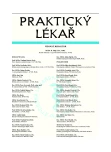Liver transplantation in children
Authors:
I. Hejlová 1; M. Adamec 2; R. Kotalová 3; M. Prchlík 4; E. Kieslichová 5; J. Špičák 1; P. Trunečka 6
Authors‘ workplace:
Klinika hepatogastroenterologie, IKEM, Praha, Přednosta: prof. MUDr. Julius Špičák, CSc., 2Klinika transplantační chirurgie, IKEM, Praha, Přednosta: prof. MUDr. Miloš Adamec, CSc., 3Pediatrická klinika 2. lékařské fakulty Univerzity Karlovy a Fakultní nem
1
Published in:
Prakt. Lék. 2010; 90(7): 436-439
Category:
Therapy
Overview
Liver transplantation is a successful therapeutic modality for children with liver failure, inborn metabolic disorders and some liver tumours. It offers long-term survival with good quality of life. Organ scarcity is being overcome due to innovative surgical techniques, which has resulted in almost no waiting-list mortality. Forty-six liver transplantations in 40 children (four of them younger than 4 years old) were performed in IKEM from 1995 to June 2009. Patient survival after liver transplantation in IKEM was:
– 84.
6 %, 1-year survival,
– 77.
2 %, 5-year survival, and
– 77.
2 %, 10-year survival.
These very good results, comparable with European and North American statistics, could only be reached through the close cooperation of the multidisciplinary team.
Key words:
paediatric liver transplantation, indications, surgical techniques, complications.
Sources
1. Trunečka, P. Indikace k transplantaci jater. Doporučený postup.
2. Spada, M., Riva, S., Maggiore, G., et al. Pediatric liver transplantation. World J. Gastroenterol. 2009,15(6), p. 648-674.
3. Leonis, M.A., Balisteri, W.F. Evaluation and management of end-stage liver disease in children. Gastroenterology 2008, 134, p. 1741-1751.
4. Alonso, E.M. Growth and developmental considerations in pediatric liver transplantation. Liver Transpl. 2008, 14(5), p. 585-591.
5. Shneider, B.L., Mazariegos, G.V. Biliary atresia: A transplant perspective. Liver Transpl. 2007, 13(11), p. 1482-1495.
6. Petersen, C. Biliary atresia: interdisciplinary initiatives focus on a rare disease. Pediatr. Surg. Int. 2007, 23, p. 521-527.
7. Davis, M.K., Weinstein, D.A. Liver transplantation in children with glycogen storage disease: Controversies and evaluation of the risk/benefit of this procedure. Pediatr. Transplant. 2007, 12(2), p. 137-145.
8. Sze, Y.S., Dhawan, A., Taylor, R.M. et al. Pediatric liver transplantation for meabolic liver disease: experience at King’s College Hospital. Transplantation 2009, 87(1), p. 87-93.
9. Treem, W.R. Liver transplantation for non-hepatotoxic inborn errors of metabolism. Curr. Gastroenterol. Rep. 2006, 8, p. 213-221.
10. Sutherland, S.M, Alexander, S.R., Sarwal, M.M. et al. Combined liver-kidney transplantation in children: Indications and outcome. Pediatr. Transplant. 2008, 12(8), p. 835-846.
11. Finegold, M.J., Egler, R.A., Goss J.A. et al. Liver tumors: Pediatric population. Liver Transpl. 2008, 14(11), p. 1545-1556.
12. Litten, J.B., Tomlinson, G.E. Liver tumors in children. Oncologist 2008, 13, p. 812-820.
13. Otte, J.B. History of pediatric liver transplantation. Where are we coming from? Where do we stand? Pediatr. Transplant. 2008, 6(5), p. 378-387.
14. Halasa, N., Green, M. Immunizations and infectious diseases in pediatric liver transplantation. Liver Transpl. 2008, 14(10), p. 138-1399.
15. Kelly, D.A. Current issues in pediatric transplantation. Pediatr. Transplant. 2006, 10(6), p. 712-720.
16. Kelly, D.A. Long-term challenges of immunosuppression in pediatric patiens. Transplant Proc 2005. 37. p. 1657-1662.
17. Al-Sinani, S., Dhawan, A. Corticosteroids usage in pediatric liver transplantation: To be or not to be! Pediatr. Transplant. 2008, 13(2), p. 160-170.
18. Treem, W.R. Beyond five years: Long-term follow up in pediatric liver transplantation. Curr. Gastroenterol. Rep. 2007, 9, p. 230-236.
19. Bucuvalas, J.C., Alonso, E., Magee, J.C. et al. Improving long-term outcomes after liver transplantation in children. Am. J. Transplant. 2008, 8(12), p. 2506-2513.
20. Ng, V.L., Fecteau, A., Shepherd, R., et al. Outcomes of 5-year survivors of pediatric liver transplantation: Report on 461 children from a North American Multicenter Registry. Pediatrics 2008, 122, p. 1128-1135.
21. Kemmer, N., Kaiser, T., Zacharias, V., Neff, G.W. Alpha-1-antitrypsin deficiency: Outcomes after liver transplantation. Transplant. Proc. 2008, 40, p. 1492-1494.
22. Prchlík, M., Poulová, P., Trunečka, P. Výsledky transplantací jater u dětí v IKEM. Folia Gastroenterol. Hepatol. 2005, 3(Supl 1), s. S28-S31.
23. Turmelle, Y.P., Nadler, M.L., Anderson, C.D. et al. Towards minimizing immunosuppression in pediatric liver transplant recipients. Pediatr. Transplant. 2009, 13(5), p. 553-559.
24. Pozler, O. Trendy soudobé pediatrie - Gastroenterologie. Praha: Galen 1999.
25. Wiesner, R.H., McDiarmid, S.V., Kamath, P.S. et al. MELD and PELD: Application of survival models to liver allocation. Liver Transplant. 2001. 7(7). p. 567-580.
26. United Network for Organ Sharing (UNOS). MELD/PELD calculator [on-line]. Dostupné na http://www.unos.org/resources/meldpeldcalculator.asp.
27. Polson, J., Lee, W.M. AASLD position paper: the management of acute liver failure. Hepatology 2005, 41(5), p. 1179-1197.
Labels
General practitioner for children and adolescents General practitioner for adultsArticle was published in
General Practitioner

2010 Issue 7
Most read in this issue
- Strabismus surgery in adults – yes or no?
- Liver transplantation in children
- Atrial fibrillation and electrical cardioversion in the outpatient cardiology department
- Asplenic patient – responsibility of all of us
